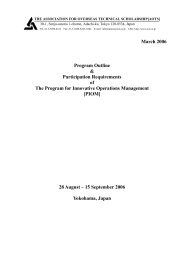Analysis of the Operation and Financial Condition of the Enterprise
Analysis of the Operation and Financial Condition of the Enterprise
Analysis of the Operation and Financial Condition of the Enterprise
You also want an ePaper? Increase the reach of your titles
YUMPU automatically turns print PDFs into web optimized ePapers that Google loves.
<strong>Analysis</strong> <strong>of</strong> <strong>the</strong> <strong>Operation</strong> <strong>and</strong> <strong>Financial</strong> <strong>Condition</strong> <strong>of</strong> <strong>the</strong> <strong>Enterprise</strong> sales limits for specific groups or series <strong>of</strong> goods are established; <strong>the</strong> terms for collection <strong>of</strong> debtors’ debts are developed; a system <strong>of</strong> contractual penalties used in cases <strong>of</strong> delays in payment isestablished.From <strong>the</strong> practical point <strong>of</strong> view <strong>Enterprise</strong> N does not have any financialpossibilities for selling <strong>of</strong> goods on credit. However, this possibility can be found on <strong>the</strong>account <strong>of</strong> <strong>the</strong> trade credit or post-payment <strong>of</strong> <strong>the</strong> suppliers. In this case <strong>the</strong> suppliers <strong>of</strong>goods are forced to instead <strong>of</strong> waiting for <strong>the</strong> payment due for <strong>the</strong> goods according to <strong>the</strong>pro-forma invoices wait ra<strong>the</strong>r for any payments received by <strong>Enterprise</strong> N from <strong>the</strong>building contractors for <strong>the</strong> works performed in which <strong>the</strong> materials <strong>of</strong> <strong>the</strong> suppliers havebeen input. Starting from Quarter 2 <strong>of</strong> 2XX9 this situation is improving due to <strong>the</strong> use <strong>of</strong><strong>the</strong> services from <strong>the</strong> factoring companies in <strong>the</strong> course <strong>of</strong> project realisation.By taking into account <strong>the</strong> order <strong>and</strong> specifics prevailing in <strong>the</strong> constructionindustry, when <strong>the</strong> policy on trade credit or payment for goods <strong>and</strong> services is drafted,<strong>the</strong>re is no need for <strong>the</strong> following three steps in <strong>the</strong> development <strong>of</strong> <strong>the</strong> said policy: <strong>the</strong> maximum amount to be channelled into accounts receivable is established; <strong>the</strong> list <strong>of</strong> goods available for sales on credit is prepared; sales limits for specific groups or series <strong>of</strong> goods are established, due to <strong>the</strong> terms<strong>of</strong> payment for <strong>the</strong> projects being established by <strong>the</strong> building contractors.Irrespective <strong>of</strong> <strong>the</strong> fact that <strong>the</strong> building contractors impose <strong>the</strong> terms <strong>of</strong> payment<strong>Enterprise</strong> N should develop a system <strong>of</strong> collection <strong>of</strong> debtors’ debts toge<strong>the</strong>r with asystem <strong>of</strong> applicable fines that can be imposed by <strong>the</strong> enterprise in cases <strong>of</strong> delays inpayments.There is a procedure introduced in <strong>Enterprise</strong> N for collection <strong>of</strong> debtors’ debts:1) On <strong>the</strong> date <strong>of</strong> payment <strong>of</strong> a debtor’s debt <strong>the</strong>re is a call made to <strong>the</strong> accountingdepartment <strong>of</strong> <strong>the</strong> debtor in question during which it is being clarified whe<strong>the</strong>r<strong>the</strong> debtor has transferred <strong>the</strong> payment or not. If yes, it is requested to send <strong>the</strong>payment order by fax, but if <strong>the</strong> amount due has not been transferred yet, <strong>the</strong>reason is found out as well as <strong>the</strong> date when it expects to pay for <strong>the</strong> debtoverdue.2) If <strong>the</strong> reason for <strong>the</strong> failure to pay <strong>the</strong> debt is substantiated, <strong>the</strong> promised date <strong>of</strong>payment is awaited.3) If <strong>the</strong> reason for <strong>the</strong> failure to pay is not satisfactory to <strong>the</strong> enterprise, areminder is issued with <strong>the</strong> request to pay <strong>the</strong> debt within <strong>the</strong> next days.4) If <strong>the</strong> debt is not paid for during this time <strong>the</strong>re is ano<strong>the</strong>r reminder sent with<strong>the</strong> request to pay for <strong>the</strong> debts outst<strong>and</strong>ing within <strong>the</strong> next days.5) If <strong>the</strong> invoices are not paid for even within this time <strong>the</strong>re is a claim being sentfor <strong>the</strong> outst<strong>and</strong>ing invoices including <strong>the</strong> warning that if this debt is not paidfor within <strong>the</strong> five next days <strong>the</strong> debt will be collected by a court procedure.6) If <strong>the</strong> debt is not paid for even within this time a second claim is being sent to<strong>the</strong> debtor for <strong>the</strong> outst<strong>and</strong>ing invoices including <strong>the</strong> warning that if this debt isnot paid for within <strong>the</strong> five next days <strong>the</strong> debt will be collected by a court. In<strong>the</strong> second claim <strong>the</strong> amount <strong>of</strong> debt is already made up <strong>of</strong> <strong>the</strong> principal amount<strong>of</strong> <strong>the</strong> debt, i.e., <strong>the</strong> amount <strong>of</strong> <strong>the</strong> invoice outst<strong>and</strong>ing, <strong>and</strong> <strong>the</strong> contractual115
















